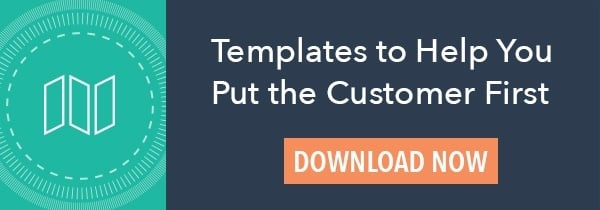11 Consumer Behavior Secrets to Satisfy & Retain Your Customers
1. Customers are driven by emotion, not reason.
A customer may have a need to purchase a laptop. However, what drives them to select a $1,600 Apple MacBook versus a $700 Lenovo ThinkPad is emotion. People like to think they're being practical -- "This one will last longer. It has better reviews. It's the latest in the market, so I know it'll be reliable."
However, deep down, they're really thinking, "Everyone else has this laptop, and I want to fit in. I already have an iPhone, so I want a laptop that can pair well with it. The new MacBook model is sleeker and more high-tech than laptops sold by other brands." Thus, when targetting customers, it's best to target their emotional side. Superb product design, thoughtful names, and ads that appeal to pathos can help drive customers to your brand for more than just the functionality of your products.
2. Help your customers physically engage with a product.
There's an ease in online shopping. Customers don't even have to leave the comfort of their bed to get all their shopping done -- from clothing to groceries to furniture. However, about 60-70% of buying decisions are made while the customer is physically in the store. This means that engaging with a product in-person can make all the difference for a customer.
When a customer has interacted directly with a product they like, it's a lot harder to let it go. A product they merely viewed online and added to their cart can be abandoned in an instance. So, it's best to get your customers through your doors and have them see, touch, and try out the product in which they're interested. Chances are the interaction will be their deciding factor for the purchase.
3. There are four major motivators for consumers.
Each customer has their reasons for selecting one product -- or brand -- over another. By knowing which customers to target and how to best target them, you can increase your brand loyalty. The four motivators are:
1. Price
Consumers motivated by price are the toughest demographic to attract. They tend not to be loyal to any specific brand, but simply select the product that is the cheapest.
2. Solution
Consumers motivated by solution are interested in the brand that can not only provide a low cost but also a reliable, valuable solution.
3. High-Quality
Consumers motivated by high-quality products want the best of the best -- and they'll typically pay more for it. They want not only the best quality but also the best customer service, shopping experience, and more.
4. Value
Consumers motivated by overall value are similar to those motivated by high-quality products. However, when provided with great value, these customers will return the favor by remaining very loyal and, often, becoming brand evangelists.
4. Consumers behave differently than they report.
Unfortunately, research studies of customers aren't always accurate. You may, for example, survey people on which coffee shop they must regularly attend. Perhaps, wanting to seem unique or relevant, they might answer dishonestly and select a local shop versus a national chain. These results, then, are invalid and unusable for researchers in truly understanding customer behavior.
The point is that customers can't always be trusted to understand their own behavior. Often, they don't even know why they do something or that a habit they have exists. It's up to researchers and brands to do the work for them by observing their natural behavior and making their own conclusions.
5. 95% of consumer thoughts occur subconsciously.
As with research surveys, customers might think that they know why they're making a purchase, but they don't always know. In fact, studies show that as much as 95% of a consumer's thoughts occur on a subconscious level. That means, what you actually inform a customer about a product might not make a huge difference compared to what they perceive and judge themselves.
This is why product design, graphics, logos, color schemes, and other visual content are so valuable for a brand. Customers can simply look at a product and make subconscious judgments about it based on its appearance. We know -- you shouldn't judge a book by its cover. However, just because you shouldn't doesn't mean you don't do it anyways. Thus, it's important to take this into consideration when designing your brand and products.
6. Consumers can better differentiate your brand from others if your employees can, too.
How many times have you or your coworkers been asked what your brand's mission is? Likely several times. And, also likely, each person gave a different, elaborate answer. If your company's own employees don't know how to differentiate their brand from competitors, how can customers do so?
It's incredibly important that your team is properly educated on what your brand stands for. There should be a unified, all-encompassing response to that question that every employee understands, agrees with, and can relay to any customer who inquires. This is what will help your brand stand out against competitors and help customers choose you for all the right reasons.
7. Customers don't just buy products -- they buy experiences.
Many consumers enjoy a daily coffee. However, what makes someone choose to go to a local coffee shop rather than stopping by a Dunkin' or brewing a cup right at home? That's right -- it's the experience. People could easily be satisfied by a cup of coffee made from their Keurig in the morning, but they enjoy the experience of ordering a custom-made latte from their favorite barista, sipping it while sitting on a comfy couch by a fireplace, and being surrounded by strangers who are all typing away at their laptops.
This mentality can apply to your brand, too, regardless of what industry you're in. The reason a customer might choose one brand over another is not just for the product. After all, it's likely your competitors have a very similar product to you, in terms of capabilities, price, and design. What sets you apart is the unique experience you provide, which often comes down to stellar customer service and ease of shopping.
8. Most customers will spend more for better customer service.
About 69% of American customers say they would spend more with a company that has better customer service. After testing this claim, it was found that customers who had the best customer service experiences spent 140% more than those with the worst customer service experiences. So, it's not just an assumption being made -- customers will actually spend more with a company if it can offer them a stronger customer service experience.
That being said, it's clear that excellent customer service should always be a top priority of companies. Customer service teams play very important roles for their teams. As one of the few customer-facing teams, customer service teams have the opportunity to build direct relationships with customers and be the final factor in whether or not a customer returns. So, spend more time and resources on training your customer service and support teams. The investment will bring back priceless results.
9. ...And they'll spend more on companies that engage more with customers on social media.
Customers want to feel valued by their favorite companies. There's nothing better than when you tweet at your favorite brand and actually receive a reply. It makes you feel seen and shows how dedicated that brand is to maximizing the experiences for every single customer.
In fact, when companies engage with their customers on social media, those customers end up being more loyal and will spend 20% to 40% more on the company than customers who don't engage with their companies on social media. The same customers also end up having a stronger emotional bond to these companies, having an average NPS®, or Net Promoter Score -- a measure of how likely a customer is to recommend a brand to others -- that's 33 points higher. Thus, connecting with your customers on social media can make a huge difference in retaining them as loyal customers.
10. You have to engage customers well before they are your customers.
You might be familiar with the idea behind inbound customer service. Companies first attract strangers through engaging, useful content, turning the strangers into visitors. Then, as the visitors engage more and more the brand, they turn into leads that can be passed onto sales. After seeing the potential in the brand beyond its free content, leads can be turned into customers. Lastly, as customers continue to be delighted post-purchase by the brand, they finally turn into promoters.
The point is that companies can jump straight from turning strangers into customers, but those customers will likely churn after a single purchase. This is because there's nothing engaging them with the brand post-purchase. However, by following the inbound methodology and engaging customers right from the start with valuable content, you can turn them into loyal customers for a lifetime.
11. The longer you engage those customers, the more likely they are to purchase from you.
Similarly, you can't expect a customer to read one blog post written by your company and immediately fall in love and purchase five of your products. Cultivating a relationship with your customers takes time. You have to prove that you have a lot to offer them before you can, so to speak, put a ring on it. And, you have to prove that what you're offering can't be offered by anyone else.
So, start by letting customers come to you. Perhaps, after reading three to five helpful blog posts, they'll subscribe to your daily email newsletter. Then, you can engage with them on a daily basis, helping them gain more of your content. After a few weeks of analyzing the kinds of posts they seem to be interested in reading, you could shoot them an email with some products or services that align with their interests. Following this path takes longer, but hooks customers for a longer time and makes them more likely to trust you and put down their credit card to make a purchase.
These consumer behavior secrets are no longer our secrets to keep. Take them into consideration when improving your customer experiences to better attract, engage, and delight your customers -- current and future.
For more information, read about next.
Net Promoter, Net Promoter System, Net Promoter Score, NPS and the NPS-related emoticons are registered trademarks of Bain & Company, Inc., Fred Reichheld and Satmetrix Systems, Inc.





